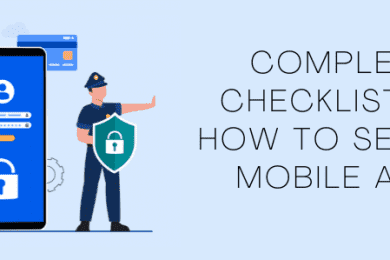In the age of technology, having a mobile device in hand is a given. Mobile devices are more widely used today than desktops or laptops. Smartphones have become an inseparable part of our daily life. Apps abound on smartphones, right? And the mobile app market is saturated with over 5.5 million apps accessible in the top app stores. However, consumers are reluctant to use any old software. They only desire the very best in the business of mobile app development.
You will surely lose the users’ trust if the app is hacked, and it is quite challenging to regain it. The development of cybercrime is parallel to that of technology. Because of the numerous security concerns in the online world, app security is essential. Everyone is being pushed online due to the COVID-19 pandemic. And the number of on-demand apps has significantly increased. Everyone has a right to be more cautious about using safe apps.
It’s time to consider the threats that could arise and boost app security with a thorough checklist. We’ll go over a mobile app security checklist that creators and business owners should think about for better user security.
COMPLETE CHECKLIST ON HOW TO SECURE MOBILE APPS IN 2022:
Following these recommendations can help you more secure your design apps.
A) Secure The Source Code of Your App
The primary component while programming an app is the source code. Many app developers now frequently use open-source code. Because hackers may quickly construct clone apps using the reverse engineering technique with the aid of online tools, open-source code is riskier.
Therefore, protecting the code is more crucial.
With a code signing certificate that aids in preventing malware multiplication and renders it completely impervious to attackers, the software code should be secure and complete. Comodo and Symantec are two well-known companies that issue code signing certificates.
B) Encrypt All Your Mobile Communications
Regardless of how hard you work on protecting the code, you must be careful with the data. IT should ensure that all communications between mobile apps and app servers are encrypted due to risks including spying and man-in-the-middle attacks through WiFi and cellular networks. To secure data while it is in transit, encryption of communication data is used along with VPN tunnels, SSL, TLS, and HTTPS communication.
C) Protect The Database
Users must be able to continue using the app without worrying about their payment information, login credentials, or other sensitive client data being compromised. However, this necessitates both the app’s and the mobile device’s security to be current.
More crucially, to prevent data breaches, the user’s database must be secured. The value of safeguarding sensitive data is recognised by app developers. Many people make sure that their apps aren’t permitted to save data in local storage as a result.
D) Provision of Multi-Factor Authentication
Users of smartphones don’t like having many identification and security checks on their devices. One of the most important safeguards for mobile app security is password preservation. It guarantees that nobody can use your device and can be configured to act in the event of a theft. Every mobile app developer knows that convenience is the key to success, and they have strengthened it.
Therefore, consumers shouldn’t experience any harm from these authentication evaluations. This two- or three-step deployment of protection is implied by multi-factor authentication. However, it may also involve a combination of pins, calls, SMS, security questions, and biometric verification.
E) Protection Against the Theft of The Device
Millions and billions of mobile devices and gadgets are either stolen or lost each year. IT should make it possible to remotely delete important data to prevent it from falling into the wrong hands, or—even better—should ensure that data is never kept on mobile devices in the first place.
IT companies should either lock or destroy the company data from employee-owned devices while keeping the private apps and files completely untouched. IT should be able to promptly restore users’ apps and data once the device is located or replaced.
F) Prevent The Leakage of Data By Any Means
IT should separate corporate apps from personal ones to prevent data leaks and still permit consumers to install different personal apps on their cell phones. To prevent malware from accessing corporate apps and users from copying, sharing, or saving critical data, secure mobile workplaces should be created. Another way to stop data breaches is:
- Avoiding copy and paste functions
- Limit the use of screenshots.
- Watermarking private data.
- Stop them from saving private files to their phone.
G) Strictly Avoid Using Personal Gadgets
Many firms permit staff to utilize personal devices for coding and testing to save on the expense of purchasing gear. This causes several code and data leaks. This is a suitable example of how malware spreads from one device to another.
To prevent this, businesses should offer a device that does not allow the installation of any additional apps, or they should install a firewall, antivirus, and anti-spam software on the devices that their employees use.
H) Enable The Device Lockout & Remote Data Wiping Options.
The definition and enforcement of user-level application policies should be confirmed by app developers. This covers features like forcing the use of special characters in passwords and remotely erasing the app data after a certain number of failed attempts at a password. It also prohibits the use of sequential numbers in passwords. These are a few methods that can be used to limit access to apps while still protecting user data.
I) Optimize The Cache Data
Cache data is typically kept on mobile devices to improve the performance of an app. Because of the increase in vulnerability of different apps and devices along with the ease with which the attackers compromise them and then decrypt the cached data. This is a significant contributor to security points.
The cache management of an app should clean data anytime it is operating in the background, even though password access might greatly lessen the likelihood of this happening. Therefore, every time the device reboots or a new user enters in, the cache data should be cleared automatically.
J) Do Not Save Your Password By Default
For user convenience, several apps save the passwords on the user’s smartphone so that the user won’t have to enter the passwords each time they log in.
By granting access to all the data in the app, saved passwords might cause a lot of problems and difficulties during cell phone theft.
Developers should refrain from keeping passwords on mobile devices to prevent this. If the customer’s mobile device is lost or other circumstances arise, the credentials can be saved in the app server so they can log in from the web server.
CONCLUSION:
To sum up, you must secure mobile apps because hackers will pose a threat in 2022 and use cunning tactics to jailbreak a mobile app. If you don’t give mobile app security a priority for your company, hackers can easily access your app and steal your sensitive company data. Therefore, strive to apply these mobile app security checklists before starting your business—or even if you are already doing so. This will definitely assist you in defending your company against any kind of theft or fraud.
My name is Sardar Ayaz a professional content writer and SEO expert having Proven record of excellent writing demonstrated in a professional portfolio Impeccable grasp of the English language, including idioms and current trends in slang and expressions. I have ability to work independently with little or no daily supervision with strong interpersonal skills and willingness to communicate with clients, colleagues, and management.
I can produce well-researched content for publication online and in print, organize writing schedules to complete drafts of content or finished projects within deadlines. I have 12 years’ experience to develop related content for multiple platforms, such as websites, email marketing, product descriptions, videos, and blogs.
I use search engine optimization (SEO) strategies in writing to maximize the online visibility of a website in search results











